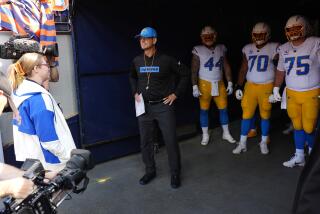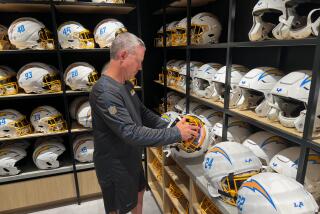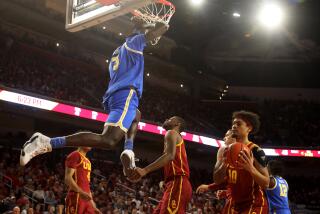Teams Need to Follow the Tough Acts With Care
Whether Terrell Owens popped painkillers in a botched suicide attempt or, as police have ruled, an accidental overdose, his actions prompted some criticism that NFL teams fail to pay as close attention to their players’ mental health as they do physical injuries.
Well, the reality is that sometimes they also ignore physical injuries.
Consider the plight of Tampa Bay quarterback Chris Simms.
He needed emergency surgery Sunday to remove his spleen, hours after it ruptured in a game against Carolina. Doubled over in pain, Simms kept playing -- except for a span in the second half when he was helped to the locker room -- unaware that his life was in jeopardy.
It wasn’t until Tuesday that he made it out of intensive care, transferring to a less dire unit inside St. James Hospital.
So, as questions swirl about how much psychological assistance teams should -- and do -- offer players, a parallel issue has resurfaced: As players get bigger and collisions get more brutal, are coaches aware enough during games to know how much is too much?
Even early on, Simms was showing signs that he was in distress. Teammates noticed in the first half that he was having trouble breathing and talking in the huddle. Late in the third quarter, after he had absorbed a slew of big hits, he dropped to a knee and was escorted to the locker room by team doctors. And he got crunched on a bootleg in the fourth quarter, a hit that Coach Jon Gruden believes probably caused the injury.
When Gruden was finally able to visit Simms in the hospital Monday, the young quarterback was more concerned about his bad throws than his battered body. “First thing he says is, ‘I missed [Joey] Galloway on a go route at the five-yard line,’ ” Gruden said.
That sums up the psychology of the NFL -- toughness above everything -- and it means coaches and medical personnel need to be more careful than ever when it comes to keeping an eye on players.
Steve Young, former star quarterback for the San Francisco 49ers, understands the pressures of the job. He also knows how far players will go to stay in the game.
“Now that I’m older and I’m a dad, my intention is to live as long as I can,” he said. “I can’t say that was always my focus.”
Maybe the most damaging label a quarterback -- or any player -- can have, Young said, is one that suggests he’s soft or fragile. A player will do just about anything to dodge that designation.
“It’s not how nice a ball you throw or how well you can find the open receivers,” he said. “It’s, can you stay in the pocket and take a shot in the face? If you can’t, you’ll find a seat.”
There was quarterback turnover in at least one NFL city this week; the Buccaneers don’t expect Simms to return this season, and he has been replaced by rookie Bruce Gradkowski.
San Diego quarterback Billy Volek understands far better than most players what Simms is going through. In his first NFL start, which came with the Tennessee Titans three years ago, Volek too suffered a ruptured spleen. But he refused to come out.
The Titans were beating Buffalo, which had the league’s top-rated defense, and Volek was on his way to an impressive victory in place of regular starter Steve McNair. The injury is thought to have occurred when Volek was flattened in the second quarter by Bills linebacker Takeo Spikes.
“He lit me up,” Volek recalled. “It was probably the hardest hit I’ve ever faced. He picked me up off the ground and asked if I was OK. I said, ‘Yes,’ and we kept on playing.”
But by midway through the second half, Volek knew something wasn’t right. He thought he might have suffered broken ribs. The pain was so excruciating he couldn’t sit upright on the bench. He had to crunch to one side, leaning at a 45-degree angle, just so he could catch his breath when Tennessee’s defense was on the field.
It was around that time that an assistant coach told him, “You’re not coming out of the game.”
Volek doesn’t hold a grudge over that. Far from it. He wanted to stay in, and was doing whatever he could to disguise the pain in his side. It was only after the game, when he dropped to the ground in the shower and couldn’t get off his hands and knees, that the seriousness of the injury became fully apparent -- to him. The medical staff figured it was merely cramping and gave him three bags of fluid intravenously.
Volek’s wife, Kerri, drove home, Billy feeling every bump in the road. He loaded up on Vicodin before going to bed -- it didn’t help much -- then woke up about 5 a.m. with his stomach looking as if he were five months pregnant. He went to the bathroom, and his urine came out fire-engine red.
Unlike Simms, Volek didn’t have to have his spleen removed. The injury ended his season, however; he needed several weeks to fully heal.
Rob Huizenga, team doctor for the Los Angeles Raiders from 1983 to ‘90, said NFL team physicians are under enormous pressure to make the right diagnoses in very difficult and confusing situations. NFL players feel such so-called normal pain during the course of a game, he said, it’s hard to differentiate between that and something more serious.
“When the players’ backs are being pummeled as part of the sport, that only adds to the diagnostic difficulties,” said Huizenga, author of the book “You’re OK, It’s Just a Bruise: A Doctor’s Sideline Secrets About Pro Football’s Most Outrageous Team.”
Huizenga said team doctors who are quick to pull players from games don’t last long. When the difference between winning and losing potentially hinges on a diagnosis, that doctor had better be right.
“If you’re not, there will be repercussions,” he said. “If you pull a guy out because you think he’s got a neck injury and you’re wrong, is that acceptable?”
Huizenga knows the answer. And that’s why he’s out of the game.
More to Read
Go beyond the scoreboard
Get the latest on L.A.'s teams in the daily Sports Report newsletter.
You may occasionally receive promotional content from the Los Angeles Times.











